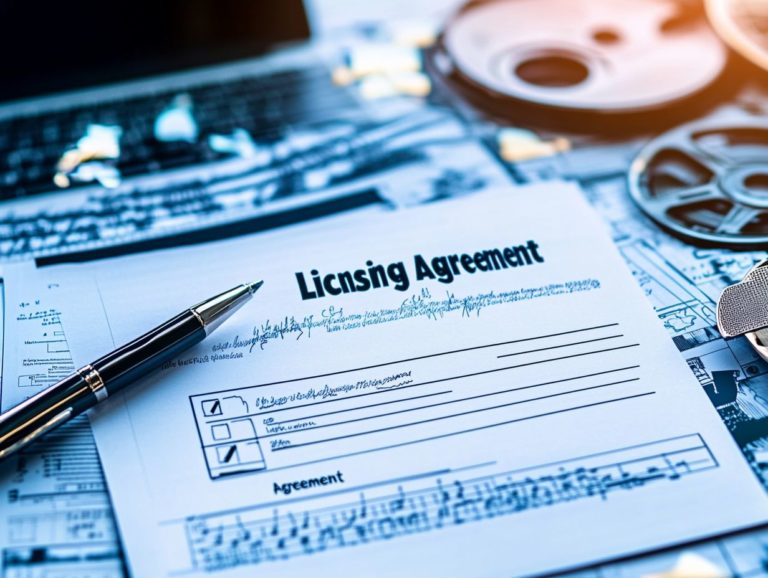The Impact of Licensing Agreements on Brand Protection
Licensing agreements are essential for protecting your brand. They act as legal frameworks that allow you to leverage your intellectual property while safeguarding your interests.
Let’s dive into the exciting world of licensing agreements! We’ll explore what they are, their benefits and drawbacks, and the key elements that contribute to their effectiveness. You’ll see how these agreements influence trademark and copyright protection and how they impact your brand’s reputation.
You ll discover best practices for negotiating and enforcing licensing agreements. This guidance ensures your brand remains protected in any scenario.
Dive in to explore how a well-crafted licensing agreement can strengthen your brand’s position in a competitive market.
Contents
- Key Takeaways:
- Understanding Licensing Agreements
- Benefits and Drawbacks of Licensing Agreements
- Key Elements of a Licensing Agreement
- How Licensing Agreements Affect Brand Protection
- Best Practices for Negotiating and Enforcing Licensing Agreements
- Frequently Asked Questions
- What is the purpose of a licensing agreement?
- How does a licensing agreement impact brand protection?
- What are the potential risks associated with licensing agreements?
- How can a brand protect itself in a licensing agreement?
- What are the benefits of a well-structured licensing agreement?
- What steps should a brand take if a licensing agreement is breached?
Key Takeaways:

Licensing agreements can offer both benefits and potential risks for brand protection. Important terms and conditions should be carefully negotiated in a licensing agreement to protect your brand’s interests. Understanding the role of licensing agreements in brand expansion is crucial, as these agreements significantly impact trademark and copyright protection as well as brand reputation.
Understanding Licensing Agreements
Licensing agreements are vital legal contracts that clearly define the rights and responsibilities of all parties involved. They are crucial when it comes to intellectual property like trademarks, copyrights, and patents.
These agreements play a key role in the commercial landscape. For example, organizations such as OpenAI, the parent company of ChatGPT, partner with leading media companies like the Wall Street Journal. This collaboration generates revenue while safeguarding their intellectual property interests.
Benefits and Drawbacks of Licensing Agreements
Licensing agreements present a complex situation of benefits and drawbacks. You must navigate these carefully to protect your brand and generate revenue, especially in sectors like consumer goods and telehealth.
These agreements help expand your market and lay out legal frameworks for financial compensation. However, they also carry risks that could impact your brand equity.
Advantages for Brand Protection
One of the primary advantages of licensing agreements is their ability to enhance brand protection through robust intellectual property safeguards, as outlined in the legal implications of licensing agreements, significantly elevating your brand recognition in the market.
These agreements often involve trademark licensing, ensuring that your brand’s identity is maintained and effectively monitored. By establishing legal frameworks that define how your brand can be used, you can prevent unauthorized usage that might dilute your image.
For example, Disney meticulously controls its licensing agreements, allowing only approved merchandise to showcase their beloved characters. This strategy not only protects the brand but also ensures that any products associated with Disney meet the company’s high standards.
Coca-Cola follows a similar approach, creating agreements that specify product quality and packaging design. This safeguards its iconic brand while extending its reach.
Through such measures, you can leverage licensing to protect and enhance your brand integrity in a competitive landscape.
Potential Risks for Brand Protection

Licensing agreements offer numerous advantages, but they also come with potential risks that could compromise your brand protection. Understanding the relationship between licensing agreements and trade marks is crucial, as issues like breach of contract and insufficient confidentiality measures can create vulnerabilities, leading to significant consequences for brands that rely on these agreements.
Imagine a scenario where your partners fail to fulfill their commitments or mishandle proprietary information. This could lead to intellectual property theft or damage to your brand’s reputation, both of which can be detrimental.
Several high-profile cases illustrate the fallout from inadequate protective measures. Companies have suffered financial losses and eroded consumer trust when licensing partners ignored contract terms. This highlights the urgent need for robust confidentiality clauses and diligent monitoring strategies within your agreements to guard against these potential pitfalls.
By taking proactive measures, you can effectively mitigate risks and ensure that your licensing arrangements provide the anticipated benefits rather than unwelcome challenges.
Ready to protect your brand? Learn more about crafting effective licensing agreements today!
Key Elements of a Licensing Agreement
A powerful licensing agreement is your brand’s first line of defense! It includes crucial elements that protect both parties’ rights.
These essential terms and conditions cover the grant of license, rights for the licensee, and interests for the licensor. They are vital for fostering a successful partnership in commercial contexts.
Important Terms and Conditions
Terms and conditions in licensing agreements are critical for defining the relationship between the involved parties. They address key elements like payments for using the brand, quality control standards, and governing law.
Take Nike, for example. They detail quality control standards in their licensing contracts to uphold brand integrity. This guarantees that any third party producing Nike-branded products follows specific guidelines, preventing subpar merchandise from damaging the brand s hard-earned reputation.
Apple enforces strict licensing terms to protect its innovative products from unauthorized duplication. By integrating these essential terms, both companies create a framework that promotes collaboration and minimizes risks related to brand misrepresentation and potential legal challenges.
How Licensing Agreements Affect Brand Protection
Licensing agreements are game-changers for your brand’s protection. They offer a structured framework for managing trademark licensing agreements and copyright rights.
This approach shapes your intellectual property strategy and boosts your brand’s value. By leveraging these agreements, you can maintain your market presence while securing your legal rights.
Impact on Trademark and Copyright Protection

The impact of licensing agreements on trademark and copyright protection is significant. They provide the legal framework necessary to monitor and enforce your intellectual property rights.
This framework minimizes unauthorized use of your licensed materials, preserving your brand’s value. Implementing effective brand monitoring strategies is crucial.
For instance, companies in the apparel sector often rely on automated software to track logo usage across online platforms, allowing them to swiftly identify and address potential infringements.
In the tech sector, patent holders vigilantly monitor new product releases to ensure their innovations aren t duplicated without permission. By using robust monitoring systems, you safeguard your trademarks and copyrights while cultivating a reputation for integrity and quality in the marketplace.
Implications for Brand Reputation
Licensing agreements can elevate your brand’s equity and market presence or diminish it. Understanding the implications of licensing agreements is vital for maintaining a positive public perception.
Consider successful collaborations, like the licensing deal between Warner Media and various merchandise manufacturers. These well-managed agreements enhance brand visibility and cultivate consumer trust.
Conversely, think about the challenges faced by Atlantic Records, where controversial artist associations sparked backlash. Poorly executed deals can swiftly alter public perception, negatively impacting sales and consumer loyalty.
Navigating these partnerships with meticulous attention is essential for any brand aiming to thrive in a competitive landscape.
Best Practices for Negotiating and Enforcing Licensing Agreements
Mastering best practices for negotiating and enforcing licensing agreements is crucial for safeguarding your brand interests. Ensure both parties benefit from well-structured terms and effective contract management.
Embrace tools like contract management software to streamline the process. Invest in training for your licensees to ensure compliance.
This proactive approach will protect your brand while fostering a collaborative and mutually beneficial relationship.
Start negotiating your licensing agreements today and watch your brand thrive!
Tips for Protecting Your Brand’s Interests
To safeguard your brand’s interests in licensing agreements, it’s essential to implement innovative strategies such as automated brand monitoring and regular assessments. These practices help ensure that your licensing arrangements remain beneficial and secure over time.
Proactively using automated brand monitoring tools enables you to efficiently track unauthorized uses of your creative works, like trademarks and logos, which is vital for maintaining brand integrity. Regularly reviewing existing licensing agreements lets you identify discrepancies or potential risks early, ensuring alignment with market trends and stakeholder expectations.
Engaging legal counsel for periodic evaluations strengthens your compliance strategies and provides an extra layer of protection. Open communication with licensees fosters collaboration regarding expectations and performance metrics, leading to more productive partnerships.
Adopting a proactive approach not only protects your interests but also elevates your brand’s reputation and longevity in the marketplace.
Frequently Asked Questions

What is the purpose of a licensing agreement?
A licensing agreement is a legally binding contract between a brand owner (licensor) and a third party (licensee). It grants the licensee permission to use the brand’s creative works, such as trademarks and logos, in exchange for a fee or royalty. The purpose is to expand the brand’s reach and generate additional revenue through the licensee’s use of their intellectual property.
How does a licensing agreement impact brand protection?
A licensing agreement plays a crucial role in protecting your brand! It allows the brand owner to maintain control over how their creative works are used and ensure that usage aligns with their brand’s image and values. Understanding the role of licensing agreements in intellectual property can help set clear guidelines and restrictions, allowing the brand owner to protect their brand from being associated with undesirable products or activities.
What are the potential risks associated with licensing agreements?
Several potential risks can impact brand protection in licensing agreements. These include the licensee not adhering to agreed-upon terms and using the brand’s creative works in ways that damage reputation or dilute value. Understanding the role of trademarks in licensing deals can help mitigate these risks. Other risks involve counterfeit products being produced under the brand’s name or the licensee failing to protect the brand’s creative works, leading to infringement by third parties.
How can a brand protect itself in a licensing agreement?
To protect itself in a licensing agreement, a brand should negotiate and include specific terms that address key areas of protection. These may include quality control measures, restrictions on the use of creative works, and provisions for monitoring and enforcing the agreement. It’s also essential to conduct thorough due diligence on the licensee and regularly review and audit their activities to ensure compliance.
What are the benefits of a well-structured licensing agreement?
A well-structured licensing agreement brings several benefits to both the brand owner and the licensee. For the brand owner, it provides a new revenue stream, expands brand reach, and increases awareness. For the licensee, it offers access to a well-established brand and its loyal customer base, potentially leading to increased sales and profits. A solid agreement ensures both parties are on the same page, avoiding potential conflicts or misunderstandings.
What steps should a brand take if a licensing agreement is breached?
If a licensing agreement is breached, the brand should review the agreement and gather evidence of the breach. Next, they should communicate with the licensee and attempt to resolve the issue through negotiation and mediation. If this is unsuccessful, the brand may need to seek legal action to enforce the terms and protect their brand’s creative works. It’s crucial to act swiftly and consult legal advisors to minimize potential damages to the brand’s reputation and value.
Contact us today to learn how we can help you secure your brand through effective licensing agreements!






